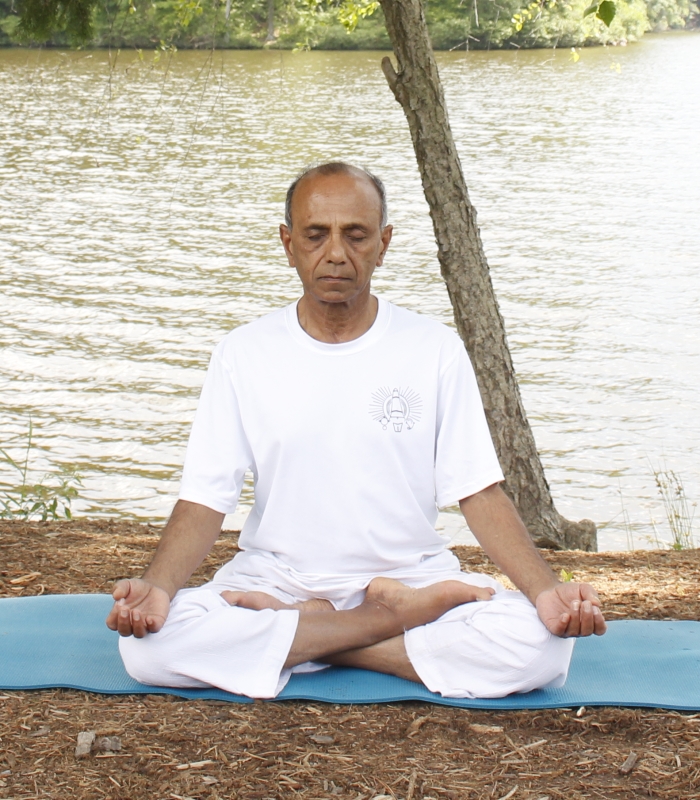Pranayama Intensive

Padmasana (Lotus Pose)
Program Information:
- What: 14-day Pranayama Intensive
- Time: 6:00 - 7:30 AM
- Location: 4000 Bearcat Way, Suite 102, Morrisville, NC 27560
- Daily Routine: Light stretching (10-15 minutes), Pranayama (40 min), Relaxation (10-15 min), Yoga philosophy (15-20 min)
- Commitment: A firm commitment to follow this schedule and attend every day
- Fee: $100
- To register: fill out the registration form, providing information in all the fields, and submit it online
Strongly recommended
- Light, 'sattvic', nutritious, vegetarian food
- No alcohol, drugs, tobacco or any other item of similar nature
- A personal commitment to continue the practice after the program is over
Daily Schedule
- Light stretching (10-15 minutes)
- Pranayama (40 min)
- Relaxation (10-15 min)
- Yoga philosophy/meditation (15-20 min)
Commitment
For the program to be successful I strongly urge you to make a firm commitment to follow this schedule and attend every day.
What is Pranayama?
Pranayama is a compound word in Sanskrit composed of 'prana' + 'ayama'. Prana is the cosmic/universal life force which is responsible for keeping us 'alive'. The word 'ayama' has two possible meanings - to stretch/elongate/expand and to control/restrain. Breath is a gross manifestation of this prana. So, the word pranayama means the ability to expand or stretch our life force (prana) by controlling the breath. Pranayama techniques involve controlling the breath in a variety of ways. According to Sage Patanjali (sutra 2.50), "Modifications of the breath are either internal, external or stopped; they are to be regulated by space, time and number and are either long or short". In this context space represents either a specific point of focus within the body (e.g. lower spine) or the left/right nostril; time means the duration of the breath; and number means the number of inhalations and exhalations or retentions. Following these guidelines, a large number of breathing techniques have been documented in the Hatha Yoga Pradeepika, the ancient text on Hatha Yoga. Over the years, many new techniques as well as different variations on the classical techniques have emerged and are widely practiced.
Why Pranayama?
Pranayama is the fourth of the eight limbs of yoga (Ashtanga Yoga) as defined by Sage Patanjali. It provides a vital bridge between the body and the mind. By controlling the breath, one can control the mind.
Since breathing is something that happens autonomously, we take it for granted. It happens while we are awake and it happens while we are sleeping. Have you ever noticed how your breathing pattern changes when you are angry, agitated or mentally disturbed? In anger, the breathing is shallow, quick, uneven and heavy. When we are calm and peaceful, the breathing is gentle, even and smooth. When we cry or are sad, we have a sobbing breath. The change in breathing happens without any conscious effort, simply based on the emotional state. So, the question is whether the reverse can also be true. That is, can we control the emotional state of our mind through breath control? According to yoga the answer is a whopping "YES"!
Modern medicine can cure us of many physical ailments - common cold to complex organ replacements. However, no simple treatments are available when it comes to dealing with tough emotional issues. For example, there is no pill that can cure us of strong negative emotions like anger, hatred, jealousy, greed and so on. This is where the power of yogic practices like pranayama and meditation have been emphasized in the traditional yoga literature. These practices provide benefits at all levels - physical, physiological, mental, emotional, intellectual and even spiritual. Regular practice is known to bring about a total transformation - toward a feeling of well-being at all levels.
Benefits of Pranayama
- Deep breathing can help with hypertension, anxiety and stress
- Improves circulation of bodily fluids within the kidneys, stomach, liver, spleen, intestines, skin etc
- Improves the functioning of the lungs
- Helps achieve correct position, shape and tension in the kidneys
- Stimulates peristaltic and segmenting movements of intestines
- Re-engineer (rewire) brain’s neural network to control emotions better
- Helps maintain flow of pure blood
- Stimulates sweat glands
- Purifies the nadis (channels of subtle energy), protects organs and cells, energizes the system
- Improves digestion, vigor, vitality, perception and memory
- Helps achieve a state of 'pratyahara' (sense withdrawal), which helps in dharana (concentration) and meditation
Program Outline
Asana Practice
- Cat and Cow (Marjarasana)
- Seated meditative asanas
- Standing arm and heel stretch
- Surya Namaskar with and without mantras
- Shoulder stretching with the help of a strap
- Reclining leg and hamstring stretch
- Bridge pose
- Spinal twist (Ardha-Matsyendrasana)
- Six cleansing techniques: Kapalabhati, neti (nasal), basti (enema), dhauti (abdomen and colon), trataka (eyes), nauli (abdominal churning)
- 5 Asanas for Laghu Shankha-prakshalana (colon cleanse)
Pranayama Practice (alphabetical list)
- Agni Sara (digestive fire)
- Alternate nostril breathing (nadi shuddhi/anuloma-viloma) with kumbhaka and bandhas
- Bandhas - Uddiyana, Jalandhara, Mula, maha bandha (all three together)
- Bhastrika
- Bhramari (humming bee)
- Deep sectional breathing
- Deep three-part yogic breathing (engaging full lung capacity)
- Interrupted breathing (2 second steps)
- Kapalabhati with bandhas
- Kumbhaka (breath retention)
- Laughter yoga
- Lion's roar
- Rapid breathing
- Sama-vritti (equal duration)
- Shitali and Sitkari (cooling breaths)
- Ujjayi breathing
- Ujjayi pranayama
- Wood-chopper pranayama
Meditation
- Definition of meditation and how to establish ongoing meditation practice
- Pratyahara guided meditation (sense withdrawal)
- Trataka (candle gazing)
- So-hum meditation
- Mantra meditation
Yoga Philosophy
- What is meditation – definition
- Definition of yoga
- How the mind functions – how the ego takes over the intellect
- Meaning and significance of OM (AUM)
- Eight limbs of yoga
- 5 Yamas
- 5 Niyamas
Reference texts
- Hatha Yoga Pradipika
- Yoga Sutras of Patanjali



